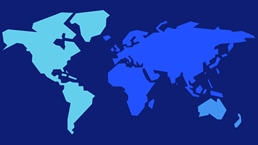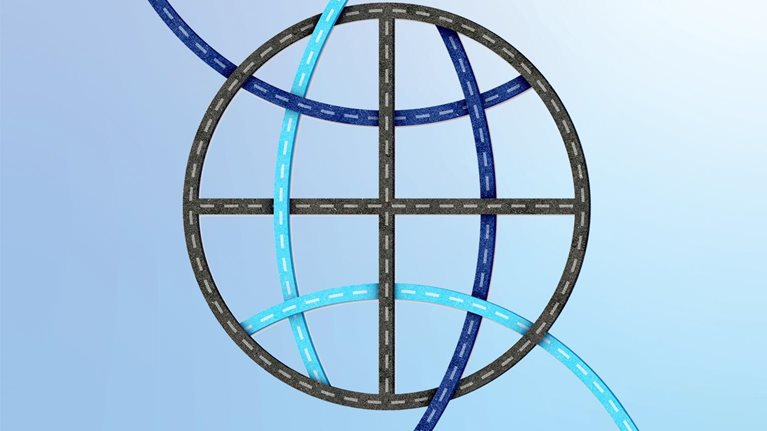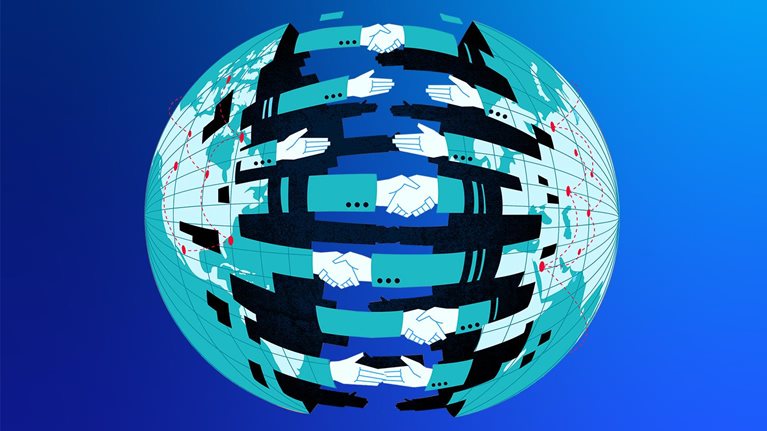The world today is deeply interconnected (Exhibit 1). The cross-border flows of trade, services, capital, people, data, and ideas that have marked the global economy for the past four decades and more—hitherto known collectively as “globalization”—have enriched the world, lifted more than a billion people out of poverty, and brought us to an unprecedented level of interconnectedness. But as CEOs and boards everywhere can now sense, these connections are fraying. This is in large part because of growing rivalries and tensions among nations, but also because of supply chain disruptions and a backlash against globalization in some parts of advanced economies. Yet global cooperation remains essential, especially in the face of challenges like climate change that require nations to work together. A new paradigm for global connection—and probably a new name—is needed.

This article outlines areas in which a new paradigm would play out, some of the complexities involved in rethinking global connections—especially trade—and the implications for different geographic regions. We conclude with some ideas about possible ways forward for CEOs and boards as they try to make sense of a changing world.
A new paradigm
The McKinsey Global Institute (MGI) has long tracked the ups and ups of global flows, highlighting their essential role in propelling global economic growth.1 But MGI has also noted the mutations underway: the ways in which globalization has been evolving and, more broadly, the consequences for the industrial base and for competitiveness, labor markets, and the social contract in advanced economies.2 It’s important to note the predominant role that global companies have played in the growth of globalization over the past four decades and the benefits that have accrued to them and their competitiveness from the opening of markets across the world.
Some analysts are now calling this paradigm into question. Global cooperation had seen net-positive growth in the decade preceding 2020 (and the onset of the COVID-19 pandemic). However, given the events of the past several years, cooperation has begun to plateau, and the world finds itself at a potential inflection point. Geopolitical tensions, including the rivalry between China and the United States and the Russian invasion of Ukraine, are a major factor, while renewed war in the Middle East could also lead to broader disruptions in the region, particularly to energy resources, and threaten peace and stability. Other concerns include the resilience of supply chains (which the COVID-19 pandemic tested), considerable discussions about the winners and especially the losers from trade, and migration. Such grievances have contributed to the rise of nationalism in some countries.
Whatever happens to globalization, continued global cooperation will be essential not just for the economy but also beyond it. Growing trade and capital flows have played a central role in raising living standards.3 Trade today supports many parts of the world.
But this is only part of the story. Cross-border cooperation also speeds up technological innovation, aids health and wellness advances, and is essential for tackling climate change challenges. All these cases require not only the exchange of ideas but also the ability to access raw materials and manufacturing capabilities that sometimes reside only in certain parts of the world. Finally, as the world is reminded each day, peace and security also rely on global cooperation.
Collaboration doesn’t just help improve outcomes; it fosters resilience and better buffers negative outcomes. Cross-border efforts are necessary to fight the trafficking of synthetics and other drugs, to take one example, and address issues concerning migrants and climate refugees, to take another. Moreover, diversifying trade ties with many partners strengthens supply resilience, while collaboration on health can accelerate global responses to disruptions (as it did with COVID-19).
Implications for trade across regions
The current, unsettled macroeconomic environment, with rising interest rates in advanced economies and ongoing geopolitical tensions, calls into question how both trade and capital flows will evolve over the next decade—not just overall but also in the patterns they will form.
Diversification can both increase resilience and give some regions opportunities to participate more fully in international trade than they have in the past. About 30 percent of trade is concentrated only because of economy-specific choices; for example, while many countries export wheat, most economies import from only a small number of these sources (Exhibit 2). An additional 10 percent of trade—including goods as diverse as laptops, soy, and iron ore—has relatively few export sources, and so diversification of these would take more effort and time (Exhibit 3).




On the other hand, some types of relationships can reconfigure themselves drastically and quickly. Many large foreign companies, for example, exited Russia following its invasion of Ukraine (Exhibit 5). That means the world may have time to think through a new global system and can afford to be deliberate—so long as it is also deliberate in how to approach more extreme forms of global disruption.



The United States remains strongly dependent on other countries in many areas—for example, over 70 percent of its mobile phones, laptops, and lithium-ion batteries come from China—but it is not acutely dependent on any one region. It has been looking to industrial policy as a route toward less dependence on others, both in raw materials and manufactured goods (supported by enacted legislation like the Inflation Reduction Act and the CHIPS and Science Act). The focus is strongest in areas identified as linked to advanced technology with military application, but this may be a broad net. For trade, there has been a rerouting of major trade corridors and flows, and Washington has adopted measures to enhance national security, competitiveness, and resilience. That said, gross imports so far seem to have shifted more than imported value added, indicating potential growth in “triangular trade”—with manufactured goods, for example, going from China to other countries in Asia–Pacific and, ultimately, to the United States (Exhibit 7).

The European Union has undergone a major shift in trade flows following the war in Ukraine: Russia had accounted for almost 10 percent of the European Union’s total imports (from non-EU countries) before the invasion, but that share dropped to just 1.7 percent by June 2023. The European Union is necessarily more dependent on other regions, particularly for its energy and mineral imports but also as purchasers of its exports (especially Germany’s). It too is looking to incorporate considerations of national and regional security, competitiveness, and resilience into its future model.
China is an anchor of intraregional trade in Asia, with its share of regional trade growing from 41 percent in 2000 to 63 percent in 2021. China has been the top trading partner of the countries of the Association of Southeast Asian Nations (ASEAN) since 2009, and ASEAN countries in turn have become China’s leading trading partners. Chinese companies have made expansion to ASEAN and other emerging economies, including those in Africa, one of their highest priorities in 2023. Meanwhile, China has dependencies of its own: it needs Brazil, for example, to provide foodstuffs and Australia to supply critical raw materials. At the same time, most of the rest of the world depends on China as a key global supplier of electronics and refined minerals. Overall, it continues to be the manufacturing hub of the world, despite some early signs of reshoring.
Latin America is embracing multipolarity. In 2000, the United States was the largest goods trading partner for almost all countries in Latin America, but China has been catching up. China is now the largest extraregional trade partner for almost all of the large economies in South America, many of which have considerable mineral wealth. The United States remains the largest partner to Mexico as well as to Central America, partially because these are areas where more US-bound manufacturing occurs.
Finally, Africa has significant potential to increase intraregional trade. African countries currently trade more with economies beyond the continent than with those within it: only 10 percent of its imports and 17 percent of its exports are intraregional. That compares with the share of trade among ASEAN countries that is intraregional, which stands at more than 20 percent. Substantial value could be generated if African public and private sector leaders can realize the potential of the African Continental Free Trade Area agreement, which aims to reduce cross-border trade constraints.

Global Trade Explorer
What can business leaders do?
The implications of the changes to globalization can touch corporations in myriad—and sometimes unexpected—ways. At the same time, as noted, multinational companies have been both at the forefront and among the major beneficiaries of the past four decades of globalization. What can business leaders do and where could they place their bets to deliver value for stakeholders and help foster global cooperation in the world? We conclude with three starter ideas.
Raise the capabilities of leadership teams
Every company, especially the largest multinationals, will be touched in some way by the ongoing mutations in globalization (including global trade flows). Geopolitical fluency needs to be treated like a muscle that can be strengthened. An understanding of global connections and geopolitical realities—and their ramifications for the business—should be a core competency for C-suite executives in every multinational corporation and a regular and systematic focus for the board, with implications for board membership and governance.4 That means not just understanding the headlines but having a subtle grasp of the nuances, context, and potential implications for the business.
Build dynamic strategic options
The old paradigm of globalization largely depended on businesses taking the lead. Now, governments are playing a greater role, and this is likely to be a core consideration for every multinational going forward. A starting point here will be a careful and clinical diagnosis of each firm’s interconnectedness—where, with whom, how—combined with a rigorous risk assessment of potential points of weakness. That understanding will form the basis for detailed scenario planning, including resilient alternatives for supply chains, and the elaboration of new strategy options that take into account dynamic world events.
Think diversifying, not decoupling
Companies that thoughtfully manage their concentrated exposures are likely to be more resilient—not only able to absorb a supply disruption but also able to bounce back better. We can already see signs of this adjustment in action: in April 2022, 81 percent of global supply chain leaders surveyed said they had initiated dual sourcing of raw materials, up 26 percentage points from the previous year. That said, any shift to supply chains may give rise to new risks, even as it mitigates existing ones. Triangular trade, for example, may diversify the ultimate sources of imports but it can also lengthen supply chains, which carries its own challenges. Remaining clear-eyed on shifting risk profiles and exploring them through scenarios is critical.





